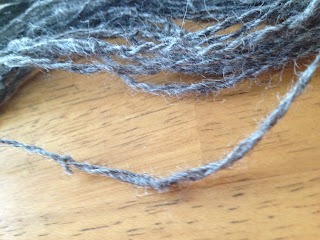I'm lucky enough to live near a community center that has a big fiber-arts room, complete with spinning wheels, spindles, and looms of all descriptions. They offer weaving, spinning, and dyeing classes at very reasonable rates.
Now, I'm not really looking for a new hobby, but I would like to learn more about how yarn is made...including where it comes from and all the steps involved in producing it. It certainly is not my goal to "never buy commercially produced yarn", but I'm thinking it could be fun to do-it-myself once in a while. One thing is already pretty clear though: spinning your own yarn is NOT a way to get it cheaper!
So...
I've had 2 lessons so far, and have taken home a "loaner" spinning wheel:
[Louet Julia spinning wheel]
So I'm sticking to sticks:
[top to bottom: Tibetan supported spindle, Russian supported spindle, 2 top-whorl drop spindles]
Spinning isn't very complicated...especially if you do it on a spindle, the process is pretty straightforward. Grab some fluff, pull it out into a thin rope, add twist with either a wheel or spindle, and wind it up. The advantage of the wheel is that the twisting and winding are done in one step. In spindling, you do it in two steps. For newbies like me, it's nice to break it down into separate steps because I can fix my mistakes.
The trick, of course, is consistency. My first week of spinning consisted of producing a lot of what can best be euphemistically described as art yarn:
[art yarn!]
Learning to pull a consistent amout of fluff out, while operating the spinning wheel or the spindle, is not so easy. I can consistently produce blobby stuff that's overtwisted in parts and undertwisted in others!
[overtwisted thin parts, undertwisted thick blobs]
This kind of yarn is really hard to knit. Looks nice on the skein but I find it hard to use effectively in knitting without ending up with "clown barf". Maybe it would look better woven? No...don't get me started on yet another hobby!!
Anyways, after a week of concentrated spindling, I'm getting a bit more consistent:
[spindled, double-ply yarn...]
...and my couch and pants are coverted in hair!
My goal is to be able to make fingering-weight yarn that's consistent enough for a decent pair of mittens or something. The above isn't quite there...but I do see already that the plied yarn I make seems a lot stronger than commercial yarn. I can't break it easily. I suppose this is a good thing.
I've tried (and hence learned about) a couple of different methods of fluff-prep: carded batt and combed roving (or roping). I find the latter much easier to spin with as it's already in "linear form". Making it by hand is quite involved though, as I've been able to learn from the InterWebz. Wondering about how this is done, both commercially and by hand, has led to me wonder where, locally, people with fluff-producing animals, get their fluff prepped...and I've found a couple of places that run basically antique equipment...Birkeland Brothers up the valley here in Abbotsford, and the Custom Woolen Mills near Calgary, AB. These fascinate me - there is so much social history here! A lot of the industrial revolution was focused around mechanizing textile production - and if you've tried spinning you'll know why!! Since my working life revolves around similar industrial processes (paper mills) I'm fascinated by the fiber equivalent. Keeping a machine like this in operation is no easy task, and making money while doing it is even harder.
I've also tried a bunch of different sheep types: merino, corriedale, and shetland. The corriedale is nice - soft and pretty easy to spin. The merino is a little harder to spin (I think it's a shorter hair) but is even softer. Kind of like the white bread of fiber. The shetland is easy to spin - nice long hairs - but very sheddy and rather rough. I like the colours, but this is outwear-only fiber. Call it the brown bread of fiber.
[spindled shetland]
[yeah, it's underplied.]
Learning about different sheep types is interesting, too. Makes one think about what kind of breeds go into our woolen clothing (and our current fixation on "merino"...), and also where the sheep actually live. Are there even any sheep in BC that are used for fiber? I know of lots of alpacas and llamas in the Cowichan Valley and on the gulf islands...
Makes me want to start a 100-mile-diet for fiber goods...
**update** just found another small fiber-processor : the Gulf Island's Spinning Mill. Looks to be a co-operative which processes local fibers (and has a small, modern setup).
**update** just found another small fiber-processor : the Gulf Island's Spinning Mill. Looks to be a co-operative which processes local fibers (and has a small, modern setup).







No comments:
Post a Comment